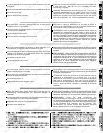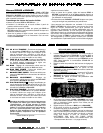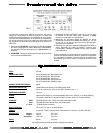
www.fender.com
6
www.mrgearhead.net
E E . V9 & V11 T ROUBLE LED* - Functional only with
the S TAND BY switch in the UP p o s i t i o n . This LED
glows re d when either the V9 or V11 tube has failed.
F F. FUSE V9 & V11 (F1)** - Protects the amplifier fro m
damage if the V 9 or V 1 1 tube were to fail. If this fuse
fails, replace the tubes in locations V 9 & V11, this fuse,
then set the BIAS and B A L A N C E.
GG. BIAS ADJUSTMENT - Trim adjustment used in
conjunction with BIAS test points to set the proper
tube BIAS.
HH. BIAS TEST POINTS - Test points used to measure
output tube BIAS.
II. BALANCE TEST POINTS - Test points used to
m e a s u re the B A L A N C E between power tube
sections.
JJ. BALANCE ADJUSTMENT - Trim adjustment used
in conjunction with the BALANCE test points to set
the proper tube BALANCE.
K K . V10 & V12 FUSE (F2)** - Protects the amplifier fro m
damage if the V 1 0 or V 1 2 tube were to fail. If this fuse
fails, replace the tubes in locations V 1 0 & V12, t h i s
fuse, then set the BIAS and B A L A N C E.
LL. V10 & V12 TROUBLE LED* - Functional only with
the S TAND BY switch in the UP p o s i t i o n . This LED
glows re d when either the V10 or V12 tube has failed.
* The TROUBLE LEDs do not indicate tube wear.
Tubes may be “worn” and sound weak even when
the TROUBLE LED still glows green. DO NOT WAIT
FOR TUBE FAILURE TO REPLACE TUBES, (see
“Tube Replacement” on the next page).
** Only replace a failed fuse with the proper type as
indicated under “Specifications” on the next page.
The fuse item F1 & F2 are used for tube failure
protection. If a fuse repeatedly fails, consult with an
authorized Fender service technician.
Visit Fender online at:
w w w . f e n d e r . c o m
w w w . m r g e a r h e a d . n e t
OUTPUT TUBE BIAS & BALANCE ADJUSTMENTS.
1. Warm up the Pro-Tube amp for 2 minutes with STAND
BY switch DOWN and OUTPUT POWER set to FULL.
Set SPEED and INTENSITY to “1“ and toggle TREMOLO
OFF. Put the STAND BY switch in the UP position.
2. Remove the bias controls cover box.
3. Set BIAS: With a DC voltmeter, measure VDC between
the “GND” and “V9,V10” test points. Adjust BIAS for .06
VDC (60mVDC).
4. Set BALANCE: With a DC voltmeter, measure VDC
between the “V9,V10” and “V11,V12” test points. Adjust
BALANCE for zero (0) VDC.
5. Replace the bias controls cover box.
IMPORTANT
1. Make BIAS and BALANCE adjustments only when
necessary. Take your Pro-Tube amp to the nearest
authorized Fender Service Center if you are not sure
about the settings.
2. Always set BIAS first, then BALANCE.
3. If the output tubes (6L6GC’s) cannot be BALANCED,
replace the output tubes (V9, V10, V11, V12), then set
BIAS and BALANCE.
BYPASS and ENGAGE Volume Levels
Use the SEND and RETURN level controls to normalize (make
equal) the ENGAGE and BYPASS volume levels. Or, set the
two levels unequal to create a preset alternate volume level,
selectable from the Footswitch. Note: The alternate volume
level will function with or without effects devices plugged into
the loop jacks.
Setting effects loop levels.
• Tu rn S E N D and RETURN knobs down to “1.”
• B Y PASS the effects loop from the rear panel or the Footswitch.
• Connect effects device(s) to the rear panel S E N D a n d
R E T U R N jacks (optional for alternate volume level setting).
• Play guitar and set the amp and instrument levels as pre f e r re d .
This is your bypass level.
• ENGAGE the effects loop.
• While playing guitar, turn S E N D and RETURN up together* to
match the bypass level set above (or to any alternate volume
level). This is your engage level.
• By quickly switching between B Y PA S S and E N G A G E w h i l e
playing, you can fine tune these settings.
*Hear unwanted distortion? Turning SEND and RETURN up at
the same rate is usually a good way of setting levels quickly
that will work with an external effects device. But with multiple
effects devices or with devices having their own level controls,
unwanted distortion may develop. Try reducing the SEND
level or the level controls on individual effects devices,
(increasing RETURN or MASTER will restore the overall
volume level). Listen for improvement after each change.
Experiment to find the right settings.
T
T
u
u
b
b
e
e
A
A
d
d
j
j
u
u
s
s
t
t
m
m
e
e
n
n
t
t
E
E
f
f
f
f
e
e
c
c
t
t
s
s
L
L
o
o
o
o
p
p
S
S
e
e
t
t
t
t
i
i
n
n
g
g
s
s


















